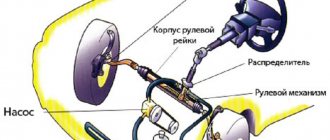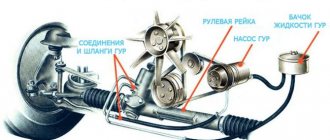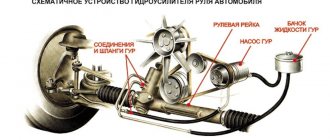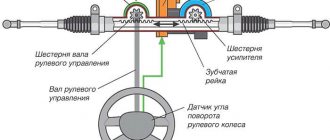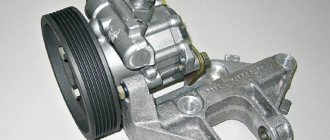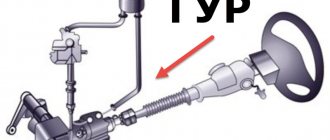To choose correctly power steering fluid, it is important to follow operational parameters and product properties. Selecting hydraulic fluid by color is a mistake, and the consequences can be disastrous for the entire hydraulic mechanism. How to find suitable oil, which brands are better and what is important to know about replacing power steering fluids?
What kind of oil to pour into the power steering
Most often, car owners distinguish power steering solely by color - red, green and yellow. But its other characteristics are much more important:
- Kinetic viscosity
- Operating temperatures
- The raw materials from which it is made
Red products are made on a synthetic basis, very rarely on a mineral basis. These mixtures are included in the ATP and are used on a limited number of models. Mineral red oil is often a Dexron 2 and Dexron 3 . Red compounds are poured into transmissions; Dextron is rarely used in power steering.
Yellow oil is made on a mineral base, this makes the cost of products more affordable. The yellow hydraulic mixture is used in both hydraulic boosters and air suspension.
The green mixture can be made from both synthetic and mineral components. It is more viscous than yellow and red. Green lubricant is never poured into an automatic transmission.
Related material: How to change power steering oil on a Hyundai Solaris?
find out which oil is suitable for a particular model in the car’s owner’s manual or on the top of the expansion tank cap. The manual contains recommended parameters and the name of the composition, the same information is usually written on the lid.
Purpose and properties of hydraulic booster oils
The oil in the power steering system performs several functions:
- lubricating
- protective,
- anti-corrosion,
- transport (transfers energy from the pump to the rail).
This set of functions is typical for another component of some modern cars - automatic transmission. Therefore, today some cars, especially those made in Asia, are designed in such a way that the same oil is used for automatic transmission and power steering.
Working fluids for power steering are divided into:
- mineral,
- synthetic.
Most cars today use mineral power steering fluids with a special set of additives. Synthetic oils for power steering are also used, but less frequently. This is due to the peculiarity of the material of the rack seals, which are quickly destroyed in the aggressive environment of synthetic oils.
Only the type of fluid prescribed by the car manufacturer can be used as a base oil in power steering. Deviation from this rule will lead to rapid depressurization of the rack.
Also, car enthusiasts often divide liquids by color - red, yellow and green. According to this “rule,” it is only allowed to mix formulations of the same color or red oils with yellow ones. This principle exists, but it is not 100% correct. For example, green liquids can be created on both a mineral and a synthetic base, so there is no need to talk about their interchangeability.
Functions of power steering fluid
The functioning of the hydraulic power steering system (hereinafter referred to as power steering) not only in passenger cars, but also in trucks, is impossible without the use of special lubricant, which performs an essential function. To figure out what kind of fluid to pour into the power steering, you need to understand what it is used for and how this unit generally works.
The hydraulic booster installed on the vehicle allows the person behind the wheel to exert a minimum of effort to control the car. What elements does this system consist of? First of all, this is a liquid pump driven by the engine crankshaft, pipelines, a control mechanism and a power actuator. The control unit is made in the form of a distributor connected to a rack or steering wheel. It allows you to control the flow of lubricant by changing the direction and angle of rotation of the steering wheel. The actuator is made in the form of a rack or steering mechanism with a bipod.
The fluid that can be poured into the power steering must meet the following requirements:
- Transfer the force from the power steering pump to the actuator, which allows you to control the wheels of the car and turn it.
- Lubricate the rubbing surfaces of the power steering system.
- Protect metal parts from rust formation.
- Do not allow the rubbing elements of the system to overheat.
The above characteristics only have a special fluid that is intended for use in the power steering system. It has specific properties that will be described below.
Composition of power steering fluid
The composition of oils in hydraulic boosters is quite typical in structure for technical fluids. Base (mineral or synthetic oil) with additives that ensure the performance and safety of the oil itself. In this, all technical oils are similar.
Oils can be mineral or synthetic based. The main advantage of mineral water is its low cost. Additives also dissolve in them better than in some (not the most expensive) synthetics. Synthetics are much more resistant to destruction factors (thermal, chemical, mechanical) and, in addition, have a much higher viscosity index (i.e., viscosity changes less with temperature changes, see the article on oil viscosity for details)
Additives:
- anti-wear, extreme pressure
- viscosity modifiers
- antioxidant
- anti-corrosion
- anti-foam
- additives that protect rubber bands in the system.
There are also coloring additives, but they can hardly be called additives, since they do not affect the functional properties of the oil in any way. Their only purpose is to facilitate leak detection.
Synthetics
These are high-tech liquids, in the production of which the most modern developments and additives are used. Oil fractions for synthetics are purified by hydrocracking. Polyesters, polyhydric alcohols and sets of additives give them outstanding characteristics: a wide range of operating temperatures, stable oil film, long service life.
The main reason why synthetic-based hydraulic fluid cannot be poured into power steering intended for mineral ones is its aggressive effect on rubber products, of which there are many in the hydraulic booster. Where synthetics are used, the rubber has a completely different composition and is made on a silicone basis.
Semi-synthetics
A mixture of synthetic and mineral oils, due to which the latter receive significant improvements in performance: reduced foaming, fluidity, heat dissipation.
Semi-synthetic fluids include such well-known fluids as: Zic ATF Dex 3, Comma PSF MVCHF, Motul Dexron III and others.
Mineralka
Mineral-based oils contain petroleum fractions (85-98%), the rest are additives that improve the performance of the hydraulic fluid.
They are used in hydraulic boosters containing seals and parts based on ordinary rubber, since the mineral component is neutral and is not harmful to rubber products, unlike synthetics.
Mineral power steering fluids are the most inexpensive, but they also have a short service life. Mobil ATF 320 Premium is considered a good mineral oil; Dexron oils up to and including the IID marking were also mineral.
Why is it necessary to add fluid to this system?
The answer is obvious: to make the steering wheel “light”. This gives even greater comfort when driving the car. However, technically it is so provided that you cannot do without a special liquid for gur. It is distributed throughout the entire system and enables high-quality functioning of the mechanisms.
Many drivers say not power steering fluid, but oil. They are partly right. The entire composition of gur is based on oil, to which chemicals are added. It is important to know that motor oil is not suitable for these purposes.
Gur liquid is an important component that is designed to perform a number of functions
- Cooling of parts that heat up during friction.
- Lubrication of power steering system elements.
- Protection of mechanisms from rust.
But the main task performed by the power steering fluid is to “lighten” the steering wheel. Due to the action of the oil, the forces from the pump to the piston are better transmitted, and the system works perfectly.
Types of power steering fluids
Unfortunately, car manufacturers have not been able to agree on the use of a universal fluid for hydraulic steering, so we have some variation in the types.
Firstly, automatic transmission oil is most firmly entrenched in the minds of motorists, and therefore in the power steering systems. This, in general, is not as surprising as it might seem at first glance, since ATF (Automatic Transmission Fluid) is essentially the same hydraulic fluid with similar characteristics, except that they are raised “plus” relative to power steering fluids (in automatic transmission conditions the work is still tougher than in power steering).
But there is also a difference, namely: the presence of a friction additive in ATPs, which increases friction for better adhesion of the clutches. And this is not very good for power steering, where additional friction is not needed. True, these additives interact well precisely with the materials of the friction clutches, which, of course, are not present in the hydraulic booster. Therefore, the Japanese, in particular (and besides them the Chinese, Koreans, and some Europeans (Renault, for example, Opel)), often recommend pouring ATF into their power steering.
Secondly, ATPs also differ from each other, and quite strongly, since different automatic transmission designs require different oil performance. We will not consider here various special ATPs created for special boxes according to the specifications of the car manufacturer (Mercedes, BMW, etc.). All these fluids are much more expensive than universal ones, and power steering is no better. So two types of ATP are relevant for us now:
- ATF Dexron II - mineral oil
- ATF Dexron III - synthetic
This is interesting: The main causes of car engine vibration at idle.
Synthetics, accordingly, are more expensive and retain their properties longer, but, according to some data, they are more aggressive towards rubber bands.
The second type of power steering fluids are special compounds under the general name PSF (Power Steering Fluid). It is possible that the additive packages are somehow super optimally selected, there is nothing extra like friction additives, but in fact this is rather a marketing ploy designed to increase the number of items sold “in one hand.” Otherwise, as already mentioned, many automakers would not recommend ATF in power steering with peace of mind.
The best power steering fluids
Power steering fluid is divided into classes: ATF, PSF and Dexron. ATP fluids are rarely used in power steering mechanisms. PSF stands for “ power steering fluid” , literally translated: “hydraulic power steering fluid”. The Dexron family is sometimes called Dextron or Dextron, these mixtures are classified as “ATF” - automatic transmission fluid.
You can get lost in the variety of products for hydraulic boosters, but choosing the right brand is actually simple. It is enough to understand the performance indicators of the mixtures. Let's compare the best power steering fluids and compile the top best fluids by class.
Which power steering oils can be mixed with each other?
Strictly speaking, it is not recommended to mix the liquids with each other - it is advisable to replace them. Before pouring new oil into the power steering container, you must thoroughly rinse the reservoir.
To understand the question of which oils can be mixed with honey (steering wheel control will remain at the proper level), and which should absolutely not be used, you need to carefully study this information:
- The first group of oils for power steering includes red and yellow mineral fluids from various manufacturers - they can be mixed without consequences
- the second group includes green mineral liquids, which can only be mixed with each other - infusion of oils of a different color is prohibited
- The third group of power steering fluids includes “synthetics” of green and orange color, which can only be used with the permission of the vehicle manufacturer, but they are interchangeable with each other
This information will a priori help you decide what kind of oil is poured into the power steering for the smooth functioning of the system.
Is it possible to mix power steering oils?
Hydraulic products can be mixed if they are similar in performance.
You cannot be guided only by the color of the composition. Yellow cannot be mixed with red and it is better not to experiment with mixing, even with mineral green, this can cause foaming.
Green products made from synthetics and mineral water should not be mixed. Red will not tolerate mixing with green.
In case of an emergency, you can take a risk and add a mixture made from similar raw materials, but driving this mixture further than a service station is not recommended. Upon arrival at the service center, it is better to immediately drain the mixture and replace it with original power steering lubricant.
What are the characteristics of power steering oils?
The question of what kind of fluid is poured into the power steering implies knowledge of the characteristics of a particular type of oil. Power steering fluids differ from each other in the following physical and chemical parameters:
- viscosity level
- hydraulic indicators
- mechanical properties
- chemical composition
In addition, oils are mainly synthetic and mineral. “Synthetics” are used less often in power steering, since the assembly elements made of rubber - seals, cuffs, etc., can dissolve when interacting with this liquid.
In turn, mineral oils can most often be found in power steering. Moreover, “mineral water” lasts longer on the surfaces of elements made of rubber and does not allow them to dry out during active use.
The presence of additives in power steering fluids also plays a role when choosing the appropriate oil:
- The power steering design is characterized by the presence of various elements made of various materials (steel, rubber, fluoroplastic), therefore the presence of an additive that improves friction between contacting parts is a prerequisite
- the absence of an additive that stabilizes the viscosity of the liquid is also unacceptable - this leads to wear in the first stages of operation and low efficiency (efficiency) during heating
- the presence of anti-corrosion additives will help eliminate unwanted formations on the internal elements of the unit, but you should not overdo it - excess leads to rapid wear of rubber parts
- additives in power steering that prevent foaming of the fluid are the key to safe driving, since bubbling oil loses the necessary compressibility and leads to a delayed response to the actions of the motorist
Additives and restoring elements made from rubber are also added to “synthetics”. In addition, additional impurities are used for color correction.
Attention! The answer to the question of what is poured into the power steering of a specific vehicle model should be obtained from the automaker on the company’s official website or in the attached detailed instructions.
Power steering oils also differ in color:
- green synthetic and mineral based oils are used exclusively in cars with manual transmission (manual gearbox)
- synthetic and mineral-based red oils are used in cars with automatic transmission (automatic gearbox)
- Yellow oils, due to their versatility, are used with equal success in both manual and automatic transmissions.
Not all fluids intended for power steering are allowed to be mixed with each other.
Attention! It is strictly forbidden to mix synthetic-based fluid with mineral oil.
The difference between a lubricant for automatic transmission and power steering fluid is the presence of different additives in the first case. Actually, the additives were specially developed for the automatic transmission clutch, which is not included in the steering design.
However, transmission oils do not have any negative impact on the operation of power steering. Moreover, Japanese manufacturers have been using the same fluids for quite a long time, both for the power steering and for the automatic transmission. The European auto industry still insists on using only fluids approved by them in cars produced by them. Someone will consider this a trick of marketers and decide that pouring high-quality, but not original, liquid will not harm the operation of the system.
For example, absolutely identical ZF brand pumps will function without complaints in various cars with different types of lubricating fluids, which are directly recommended by the manufacturer itself. In other words, green or yellow oil is equally suitable for smooth operation of the power steering. The difference is only in the color of the substances.
However, practice has shown that not everything is so rosy. In some situations, the interaction of these two oils causes the liquid to foam. Of course, the problem can be solved simply - before pouring in another liquid, you need to thoroughly rinse the container. But the fact, as they say, is a stubborn thing.
Attention! Again, based on practice, we can safely say that Dextron class mineral oils are perfectly combined with lubricating fluids for power steering - additional impurities do not come into confrontation with each other and continue to perform their functions efficiently.
Changing the power steering oil
If the power steering mechanism works properly and without leaks, the composition needs to be changed every 1-2 years , depending on the manufacturer’s instructions. Periodically you need to check the fluid level; it should be between the minimum and maximum marks.
Adding fluid
The lubricant in the power steering can gradually evaporate due to high temperatures in the system. If during the service interval some of the mixture has left the power steering system, you can add the required amount. To do this, open the expansion tank, fill the product up to the MAX mark, turn the steering wheel, pump the system and, if necessary, add more.
Complete replacement
You can change the power steering oil using two jacks, a syringe and a container for waste material.
- The front of the car must be raised so that the wheels are in the air.
- Open the expansion tank and use a syringe to pump out the bulk of the old mixture.
- Next, you need to remove the main hose from the pump, it is usually located below, and lower it into a container to drain.
- Turn the steering wheel to bleed the mechanism, wait for it to drain and put the hose in place.
- Remove the return hose, lower it into the same container, pump it and install it back.
- The engine must be turned off during this procedure.
When the used material is completely drained, fresh material can be poured in. Pour in up to the maximum mark, pump the mechanism by turning the steering wheel. Part of the composition will leave the tank into the system; you need to top it up again. It is necessary to pump and top up several times until the entire power steering mechanism is filled and the oil is at the same level.
Features of replacing fluid in the power steering
For drivers who find it difficult to decide what kind of oil should be poured into the power steering, experts recommend checking the information in the vehicle passport.
In cases where an urgent replacement of power steering fluid is needed, but the original composition is not at hand, you should be guided by existing analogues. It is advisable to know the following important rules:
- Green gur oil can only be mixed with a composition of the same color.
- The yellow mass can be mixed with the red one without harming the power steering.
- If red oil was previously added to the tank, a yellow compound can be added to it.
- Under no circumstances should synthetic and mineral oils be combined. The color rule does not apply here.
- If the manufacturer has not indicated that synthetic liquid can be added to the tank, it is advisable to fill it with a mineral-based composition. This is guaranteed to increase the service life of power steering parts.
As a rule, 1 liter of fluid is enough to replace it in a passenger car. For trucks this value can reach 4 liters. The volume may change slightly up or down, but you should focus on these numbers.
Adding fluid
To add oil, it is recommended to purchase Multi HF universal fluid, since it can be mixed with absolutely any lubricant.
Instructions for adding hydraulic lubricant to the power steering:
- Inspect the power steering reservoir and mechanism for leaks. If there are any, they need to be eliminated;
- Check the hydraulic oil level in the power steering reservoir;
- After removing the plug, add fluid to about;
- Start the engine and turn the steering wheel from the extreme left to the extreme right;
- Check the lubricant level in the power steering reservoir and, if necessary, top up to about.
Complete fluid change
A complete lubricant change requires great perseverance and coordination. Hydraulic oil must be selected based on the manufacturer’s recommendations.
- Hang up the car. This is done to facilitate rotation of the steering wheel when the engine is off;
- We will need a syringe - we need to pump out all the fluid from the power steering reservoir;
- Then loosen the clamps on the hoses, remove them from the tank, rinse the container itself thoroughly;
- Direct the return line (steering rack hose) into an empty jar - the liquid remaining in the rack will drain there;
- By turning the steering wheel, remove any remaining lubricant from the mechanism. It is required to make quite intense and prolonged movements with the steering wheel;
- After the hydraulic oil stops leaking, you need to fill (rinse) the rack with freshly purchased fluid. To do this, insert a funnel into the second hose and fill it to capacity;
- After this, we repeat the manipulations with the steering wheel again. When all the oil has flowed out of the return hose, the procedure can be completed;
- Then reassemble the hydraulic power steering system in reverse order;
- Fill the mechanism reservoir with oil according to the level;
- After the system is filled, you need to turn the steering wheel from the extreme left position to the extreme right. Such manipulations should be carried out with the engine running;
- We turn off the engine, lower the car, check the tightness of the connections, and add fluid to the amplifier tank to the maximum.
This is interesting: Replacing the rear and front wheel bearings of Renault Megane 2
Which power steering fluid to choose in 2021
When choosing hydraulic products, you should be guided by the chemical composition and operating conditions of the products. The best hydraulic oils are presented in this selection. Each of these products meets quality standards and has excellent characteristics in its class.
It is necessary to select a hydraulic product taking into account the recommendations of the car manufacturer, but you can easily replace the original oil with a similar one from the TOP 20 best.
Purpose of power steering
You can often hear the opinion among car enthusiasts that if the hydraulic booster fails, this is fraught with an emergency. And some argue that the steering wheel will completely jam and the car will lose control. Only someone who has a vague understanding of the design of the steering can say this.
Yes, if the hydraulic steering system fails, this will affect the performance of the car. In particular, turning the steering wheel when the car is stationary or when it is moving at low speed will become much more difficult. And a fragile girl can hardly cope with this task.
But in general, no really dangerous and irreversible consequences will arise, even if the hydraulic booster completely fails. And at speed, the absence of power steering will be almost noticeable.
The purpose of hydraulic power steering can be understood from the name. This element is not load-bearing or necessary for the functioning of the steering. It only increases the force applied by the driver to the steering wheel.
On the vast majority of not only passenger cars, but also vehicles in general, power steering plays a supporting role.
The exception is trucks, in which there is often no direct mechanical connection between the steering wheel and the steering wheels. For example, a similar solution was used in the design of the world's largest BelAZ mining dump trucks.
What is grease used for in power steering?
- transmission of force from the pump to the distributor and from the distributor to one of the working cavities of the rack;
- lubrication of rubbing elements;
- corrosion protection;
- maintaining heat balance.
For normal operation of the hydraulic booster, oil is needed that not only performs all of the above functions, but also does not harm the internal parts of the power steering.
As you know, most technical fluids in a car have a limited resource and need to be replaced after a certain period or mileage. These fluids also include power steering oil.
Why you need to change the power steering fluid, details about the problems - video
The period between successive replacements is in most cases indicated in the vehicle's operating instructions. Working periods can be calculated in kilometers and time intervals. These periods are about 30–45 thousand kilometers or 2–3 years.
A logical question arises here: what kind of oil should be poured into the power steering? And can other liquids be used? It all depends on the car model and the oil filled before.
Some hydraulic power steering systems are designed to work with certain brands of fluid, others imply the ability to mix with similar compounds, and still others can be filled with almost any oil without problems, after first flushing the system.

